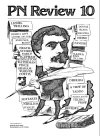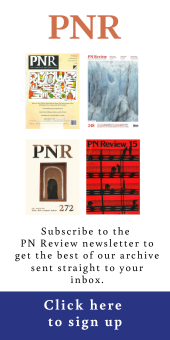This article is taken from PN Review 10, Volume 6 Number 2, November - December 1979.
Notes on a Viking ProwTO RECAPTURE poetic reality in a tottering world, we may have to revise, once more, the idea of a poem as an expression of the "contents" of a subjectivity. Some poems, at least, and some types of poetic language, constitute structures of a singularly radiant kind, where "self-expression" has undergone a profound change of function. We experience these structures, if not as revelations of being, then as apertures upon being. We experience them as we experience nothing else.
Yet we say that a poetic text is not this or that thing out there. We say that such a virtual thing as a text is not an actual thing, that it is not even thing-like at all. Or we say that this or that text occupies an interface between things and persons, but has its ontological status only c/o the addressee, who is itinerant and anonymous. Look at the problem this way: Might it be that we are forgetting what a thing as artifact firstly is and secondly signifies? We might be forgetting, in particular, about the intrinsic virtues of pre-industrial artifacts, not only ones that had explicitly sacred value.
Lace, icons, hand-blown glass, hand-struck Greek coins, bone implements, masks, figurines, old books, paintings, carts and bedspreads and ploughs-such hand-made things are real, did become real, because they were brought to life by currents of formalized energy, desire crystallizing as it passed from imagination to skilled hands, through to treasured materials, and back again in a ...
The page you have requested is restricted to subscribers only. Please enter your username and password and click on 'Continue'.
If you have forgotten your username and password, please enter the email address you used when you joined. Your login details will then be emailed to the address specified.
If you are not a subscriber and would like to enjoy the 284 issues containing over 11,400 poems, articles, reports, interviews and reviews, why not subscribe to the website today?
If you have forgotten your username and password, please enter the email address you used when you joined. Your login details will then be emailed to the address specified.
If you are not a subscriber and would like to enjoy the 284 issues containing over 11,400 poems, articles, reports, interviews and reviews, why not subscribe to the website today?




